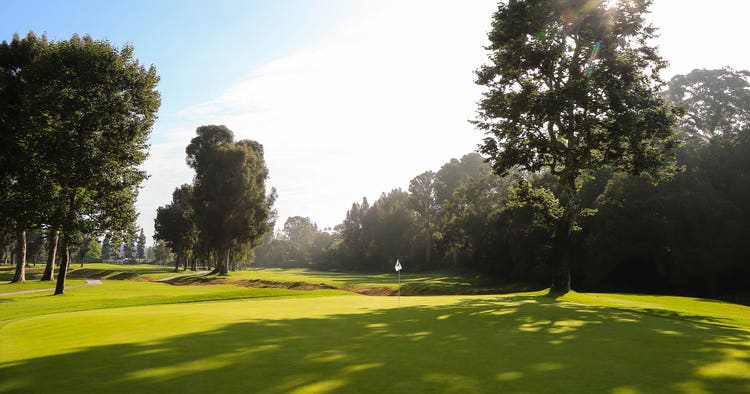

Center Stage
How Riviera brings out the best in today’s stars
Presented by


The first tee at The Riviera Country Club is a historic setting for the start of a round … or a career. Tiger Woods was 16 years old when he made his PGA TOUR debut here in 1992.
From Hogan to Nicklaus, Palmer to Woods, all of the game’s greats have competed at Riviera. That continues today as Woods hosts The Genesis Invitational at the course where his 82-win career began.

The proposed site for The Riviera Country Club was a flat and barren canyon floor. It was unimpressive at first glance, but it caused one of Riviera’s co-founders to exclaim, “This is it! This is it!” as he surveyed the land from above.
The sandy soil allowed architect George C. Thomas to shape a course that still tests players today, nearly a century after its opening. From that elevated first tee, which sits 75 feet above the fairway, players dive into one of the game’s most historic courses.
(George C. Thomas) transformed the floor of the Santa Monica Canyon into a completed art form so natural that nearly any stranger … would be hard-pressed to detect any evidence of the hand of man.
Ben Crenshaw, The Riviera Country Club: A Definitive History
‘Variety’ isn’t just one of Los Angeles’ must-read publications. It also was a tenet of Thomas’ architectural philosophy. He wanted players to face a myriad of shots on his courses, not a singular challenge. He also was a firm believer that a course should require strategy and reward golfers for bold play.
“In considering our ideal or championship course, let us remember the value of diversity, and let us include in such a course as many varied shots … as possible,” Thomas said.


There is a 70-yard span between the longest and shortest of Riviera’s par-3s. The 236-yard fourth hole (pictured) is fashioned after the famed Redan in Scotland. Ben Hogan called it “the greatest par-3 hole in America.”
The short 16th, which plays just 166 yards, is an island of grass surrounded by Thomas’ trademark flowing bunkers. “Any time you walk off that green with a 3,” said Byron Nelson, “you can be happy.”
In golf construction, art and utility meet; both are absolutely vital.
George C. Thomas

Art and utility are surely entwined at Riviera’s sixth hole. A bunker in the middle of the green makes it one of the most unique holes in the world and confounds players with a challenge they rarely, if ever, encounter.
“Many architects before him divided greens into sections to provide variety. They did so by using plateaus or mounds or troughs. But no one had ever used a hazard,” author Geoff Shackelford wrote in Riviera’s club history. “What Thomas really accomplished with that solitary bunker was to eliminate the obvious target, the center of the green.”

The heart of Riviera’s front nine showcases some of Thomas’ most unique holes. After the par-4 fifth, where a large man-made mound obstructs the view of the green, and the donut par-3 sixth, players come to the short but strategic seventh.
The farther a player hits the tee shot on the 408-yard hole, the narrower the fairway gets. A bunker encroaches from the left and a barranca is on the right. Hitting to the widest part of the landing area leaves a longer approach. “The spirit of golf is to dare a hazard and by negotiating it reap a reward,” Thomas said.
My what bunkers! There must not be any better sand traps in the world. They almost seem to have a life of their own the way the edges snake and curve, roll and dip.
Tom Kite, The Riviera Country Club: A Definitive History

Just as a chain is no stronger than its weakest link, so no man’s golf game can hold together if there is one weak link in his chain of shots.
George C. Thomas

The back nine’s first two holes offer birdie opportunities before Riviera closes with a series of bruising par-4s. Four of the course’s five longest par-4s are on the back nine. The 479-yard 12th may be difficult but it also provides a reminder that the club is mere miles from Hollywood.
Mel Brooks lived in a home above the hole and the tree left of the 12th green is known as “Bogey’s Tree” because Humphrey Bogart used to sit underneath it while watching the tournament. Approach shots must squeeze between that tree and a bunker on the right.

While the previous hole required a left-to-right tee shot, the opposite is needed on the 459-yard 13th. A barranca runs along the entire left side of the hole, but those who bail out must deal with eucalyptus trees off the tee and are left with a downhill chip if their approach misses right of the green.
“This principle of extreme trouble to one side of a hole, with equally difficult but less assuming hazards to another side” is one Thomas learned from another famous architect, Donald Ross, according to Riviera’s club history.

After the par-3 14th, Thomas challenges players with the course’s longest par-4 and one of its most dramatic hazards. Players who drove into the 15th hole’s fairway bunker in 2022 averaged 4.6 strokes on the hole and hit the green just 18% of the time.
“No hazard which is visible is unfair,” Thomas wrote. Tiger Woods concurs, saying Thomas “makes it abundantly clear, here’s the bunkers. Don’t go in them.”
The last three holes should be of exceptional character, and the last hole, undoubtedly, should be a fine (par-4).
George C. Thomas

WRITER AND EDITOR: SEAN MARTIN
PRODUCER: ALISTAIR CAMERON
CREATIVE DIRECTION: PAUL DEVAULT
VIDEO EDITORS: JASON BODDY, JACK MOREL
PHOTO EDITOR: KEYUR KHAMAR
PHOTOGRAPHY: GETTY IMAGES, THE RIVIERA COUNTRY CLUB
PROJECT MANAGEMENT: TRAVIS SMYTH
PRODUCT MANAGEMENT: BRIAN VAN ALSTINE, TIM LANGER
